Stobs Camp Project

Contact details: Project Manager: Dianne Swift
development@archaeologyscotland.org.uk
0300 012 9878

Location
What are the aims of your project?
This community project is led by Archaeology Scotland in partnership with Scottish Borders Council, Historic Environment Scotland, the Hawick Archaeology Society, Hawick Callants Club, Borders Family History Society, Hawick museums, landowners, societies, youth groups and schools.
Stobs Camp Project aims to encourage both local people and the global online community to:
- better understand Stobs Camp and the part it played in the First World War
- to value, share and commemorate Stobs and the people who lived there
- to protect Stobs Camp for future generations
Stobs Camp is unique in Europe as so much of the original buildings survive and so many artefacts of the time are available to help tell the story of civilian internees and POWs.
How will the project achieve these aims?
Activities will include historical research about interns, prisoners, soldiers and guards and the impact on the local community. The main camp, cemetery and ancillary buildings are being archaeologically recorded. Small-scale excavations are being undertaken on targeted sites.
Local volunteers, schoolchildren, youth and local societies are helping to explore, investigate and record the site. Many of the schoolchildren are working towards Heritage Hero Awards. Video footage of activities is published and a mobile phone app for the site is under development.
In the future we plan to reinstate the cemetery memorial, arrange an armistice event for 2018, an international conference for 2019 and produce learning guides and books.
Ultimately we will develop a management plan and make an application to HES for consideration of designation. The website will remain property of the local community will be available for further research. We will install new interpretation for the site and look to improve access and parking.
Who’s involved?
Archaeology Scotland covers project management and skills training but the local volunteers and schoolchildren are at the heart of activities. Young people exploring newspaper archives, genealogists research family records, volunteers surveying, digging and searching for missing huts are just some of the current undertakings. The support of the landowners and local heritage services mean an awful lot to the project and the publicity from social media, newspapers and television is helping to put Stobs Camp on the international map.
How was the project funded?
Following a development phase in 2016 we have funding from Heritage Lottery Fund, Scottish Borders LEADER, Fallago Environment Fund, Historic Environment Scotland and Scottish Landfill Community Fund (BCCF Environmental) totalling over £250,000 for a 2 ½ year period.
Where did you go for help and advice?
Having a development phase was vital to have the time to bring all interested parties to the project and to have the time to source all the necessary funding. All the funders were extremely helpful with practical advice on applications and helping to make links with potential partners.
What has been your greatest achievement so far?
We are proud of all our volunteers’ efforts so far, with the children achieving Heritage Hero Awards, with the numbers of people coming to training sessions and helping with surveying and excavations. Our greatest achievements are yet to come so watch this space.
And the biggest challenge?
Managing people of all ages and from very diverse backgrounds can present its challenges but the enthusiasm and determination of our partners and volunteers exceeds expectations.
Any tips for those setting up a similar project?
It is vital to talk to as many groups, societies and local services as possible before embarking on a project of this size. It has to be able to achieve realistic aims that fit with many diverse desires and statutory aims. Leave plenty time for this and ensure support is on board before applying to many funders.
What’s next for your project?
Over the summer of 2017 volunteers will continue surveying and all the information gathered will help to inform the management plan. The team will be surveying and recording missing huts in situ all around the area. Genealogy volunteers will be gathering stories of people who lived, worked or were interned at Stobs during the First World War. Over the winter months we will continue with the research and the desk-based activities in preparation for the next outdoor season in spring 2018. We will be continuing to work with the schools and other volunteer groups by running workshops on various archaeological and heritage skills. During 2018 we will also be planning some activities to showcase the work we have been doing and, of course, will have a commemoration event in November.
- Log in to post comments